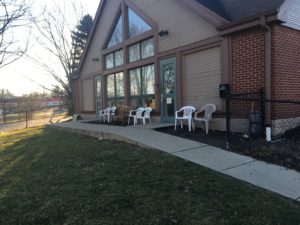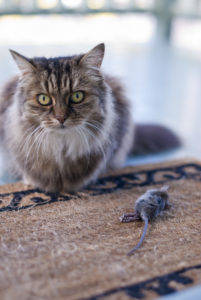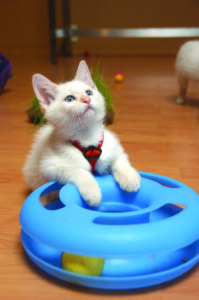As practices and shelters are looking to incorporate Low Stress Handling skills into their daily routines, our work at CattleDog Publishing continues to grow. I recently traveled to the Midwest to present full day seminars on Low Stress Handling. I had a wonderful group of DVM’s, technicians, trainers, and some of the staff from Indy Humane.
Colleen Benson, the head of the behavior team at Indy Humane gave me a tour of the facility. It was there that I found Dr. Liz Rose busily hanging shelves, painting crates, and creating a “cat-astic” space for the adoptable cats. This wonderful area was created using a few dollars and lots of creativity.
To get straight into it, what is environmental enrichment and why is it important? Behavior enrichment, also known as environmental enrichment, “is an animal husbandry principle that seeks to enhance the quality of life by identifying and providing the environmental stimuli necessary for optimal psychological and physiological well-being” (1). Feline enrichment means adding perches, small piles of food hidden to activate hunting drive, and an outlet for predatory play. Exploring linked perches, providing resting areas that are partially enclosed, hunting for food (no big bowls sitting out) allow the cat to express normal behaviors that are limited in an indoor home. In short, it makes the world the cat lives in more interesting and engaging. The cat needs to hunt for food. The additional perches also allow the cat to get away from stimuli that may be startling and expands the space the cat identifies as home. Various textures such as carpet, wicker, actual tree trunks with bark, and fleece encourage facial marking, which is how a cat marks his or her home.
The importance of the environmental enrichment of the feline home, is finally being understood. Last February at the Midwest Veterinary Conference, Dr. Tony Buffington presented information on “Pandora Syndrome” (2). This syndrome is the collection of chronic health problems, such as interstitial cystitis, obesity leading to diabetes, intestinal disorders, and some dermatologic conditions. These conditions often have household stress, or intensifier, as the cause. The cat is physically ill – there is a pathology in the skin, bladder or intestines. Yet, the condition reoccurs until there is enrichment in the home. When enrichment is added, relapses stop.
The impact of these diseases can be very serious. The diabetic cat can fluctuate with insulin according to stress, exercise, diet, and insulin therapy response. Feline interstitial Cystitis (FIC) is a very painful condition, causing litter box aversion. The cat is in a lot of pain, it is damaging the house, and the problem does not always respond well to medication. However, it will respond to enrichment. There is building evidence that vomiting and Irritable Bowel Disorder in cats are linked to environmental stress (3).
In my clinical experience, I found that if an owner enriched the home by adding 3 perches per cat, playing 10 minutes per day where a cat “kills” a toy, and tosses food for the cat to pounce on and eat, there were far fewer health problems. This plan helped many obese cats lose the 20–30% of the body weight they needed and reversed diabetes, vomiting problems, and urinary troubles. Food puzzles and hiding piles of food is another way to activate the hunting skills. They may wait until nightfall, but I never had a cat who did not eat the hidden food. There was never a problem with bugs or vermin, but they always found it.
As humans, we look at companion animals as an extension of ourselves. We think they want the same things we want; that is not so. There are comforts we both enjoy, but how a cat eats, how a cat needs to scent share, and have vertical space for security is unique to felines. While I support an indoor cat lifestyle, we need to allow normal feline behaviors to be expressed. Yes, we need to accommodate the cat’s needs into our home. That can be done in a way that does not have us living in a cat home. When you look at the space at Indy Humane, you can see how shelves, scratching pads, and cubbies blend into the area that the staff also needs to traffic through. If a shelter can do this, so can you.
As a veterinarian, I get some push back from enrichment ideas. I hear that “it is a pain to hide food,” and “my cat plays all of the time on its own” and that no one wants to have large cat trees eating up the living room space. We need to look at life through the animal’s eyes and not our own. Enticing our cats to play using their hunting skills is much more fun than playing alone. As I say, “A happy cat is a cat who thinks he killed something every day.” When clients would play allowing the cat to express the predatory pattern, they saw how their cat was more settled, and happier. This now enabled the client to see life through the eyes of their pet and therefore, have a more open view of their world.
Here are some additional resources to give you some ideas and plans for enriching your home for your feline friends:
This blog post provides step-by-step instructions to create the same pressure fit cat tree that graced my waiting room at Okaw Veterinary Clinic. No screws or nails mar the walls and the footprint was only 2 feet by 2 feet.
The No Bowl Feeding System by Liz Bales DVM, provides a system to measure the food into small puzzles that are hidden – Dr. Bales has multiple studies of how this system has reduced obesity, reduced FIC and enhanced the welfare of cats. The cost of the product is small for all the benefit it gives.
For cat toys, you need a toy box to rotate toys daily – have a variety of wand type, wool or fleece texture, and things that roll or skitter around. CatConnection.com has a great variety to choose from. Always inspect toys and remove loose parts or strings.
A big thank you to Dr. Rose, Colleen and the staff at Indy Humane who hosted my “Essentials of Low Stress Handling” seminar. I look forward to coming back to Indy Humane to collaborate on Low Stress Handling in Shelter care, and other seminar days. I will be speaking in the Milwaukee area (Brookfield), Tuscola, IL and Suburban Chicago (Northfield) this March and April. Watch this website or visit LowStressHandling.com for dates and details. I hope to see you there!
References
- Shepherdson, D.J. “Tracing the path of environment in zoos” in Shepherdson, DJ., Mellen, J.D. and Hutchins, M. (1998) Second Nature – Environment Enrichment for Captive Animals, 1st Edition, Smithsonian Institution Press, London, UK, pp.1–1
- Buffington, Tony, DVM, PhD, DACVN. “Pandora Syndrome: rethinking our approach to cystitis in cats.”Veterinary Medicine, October 1, 2011.
- Ohio State University College of Veterinary Medicine. “Even healthy cats act sick when their routine is disrupted.” Science News, January 4, 2011.






